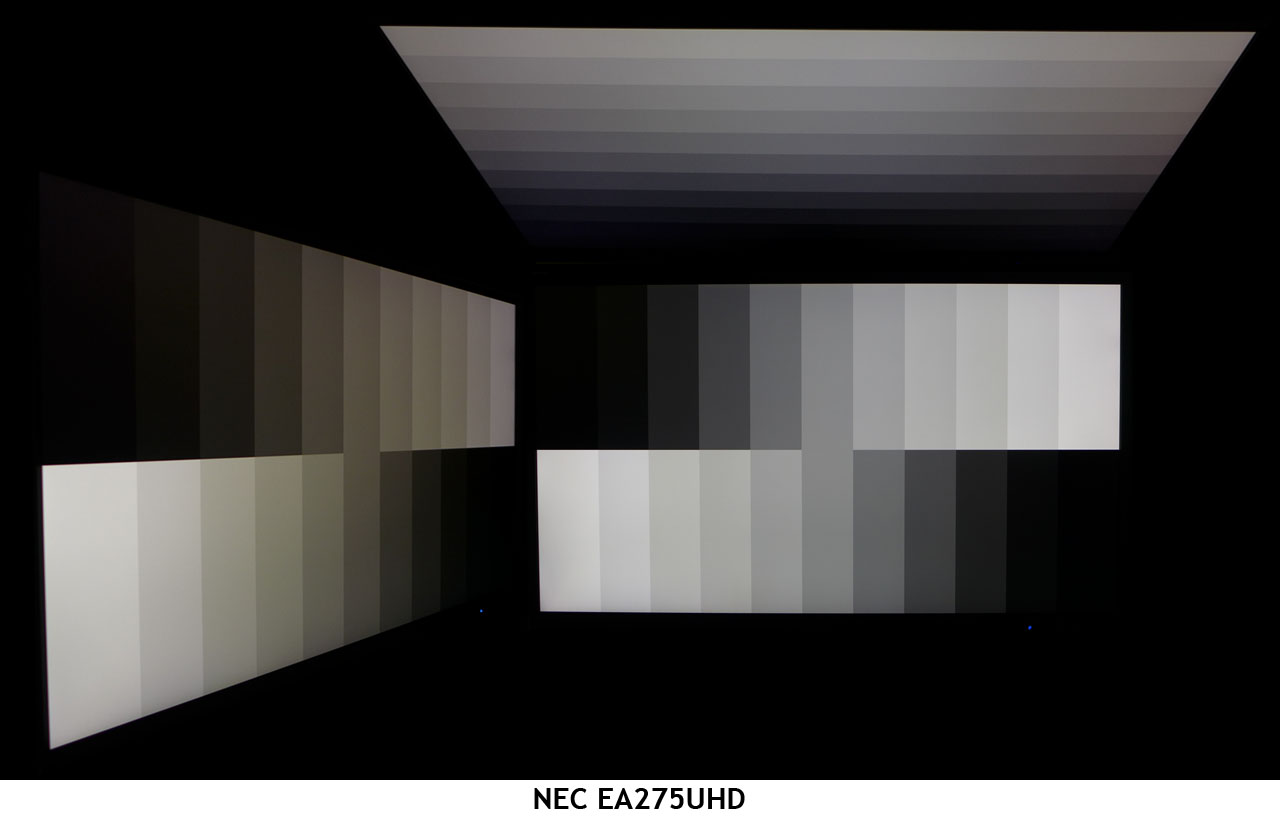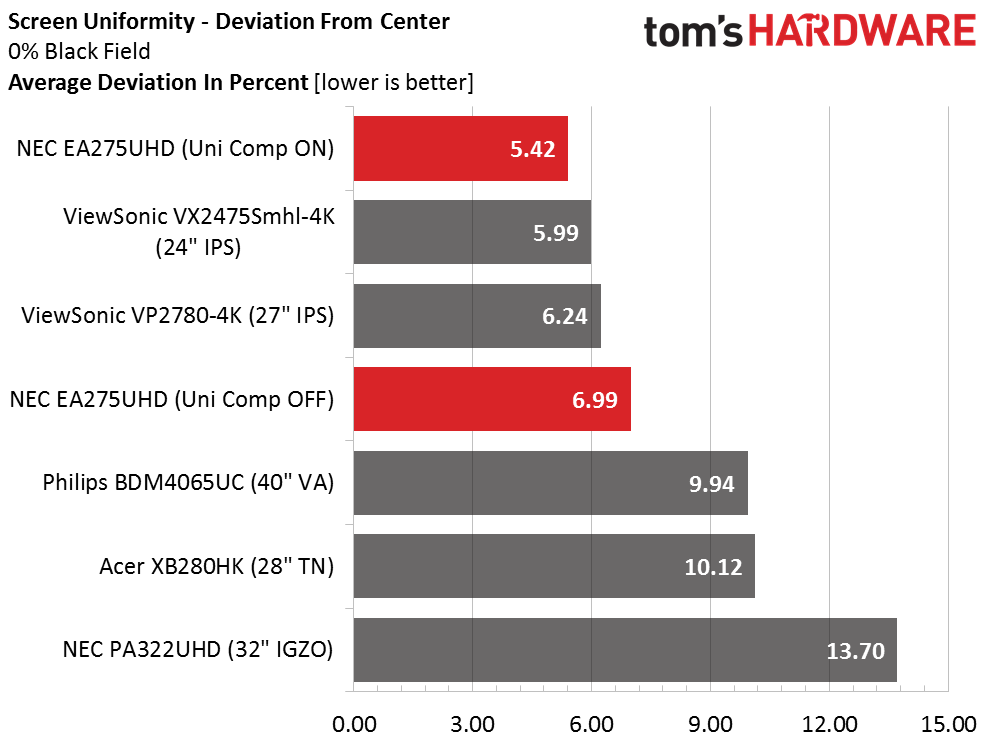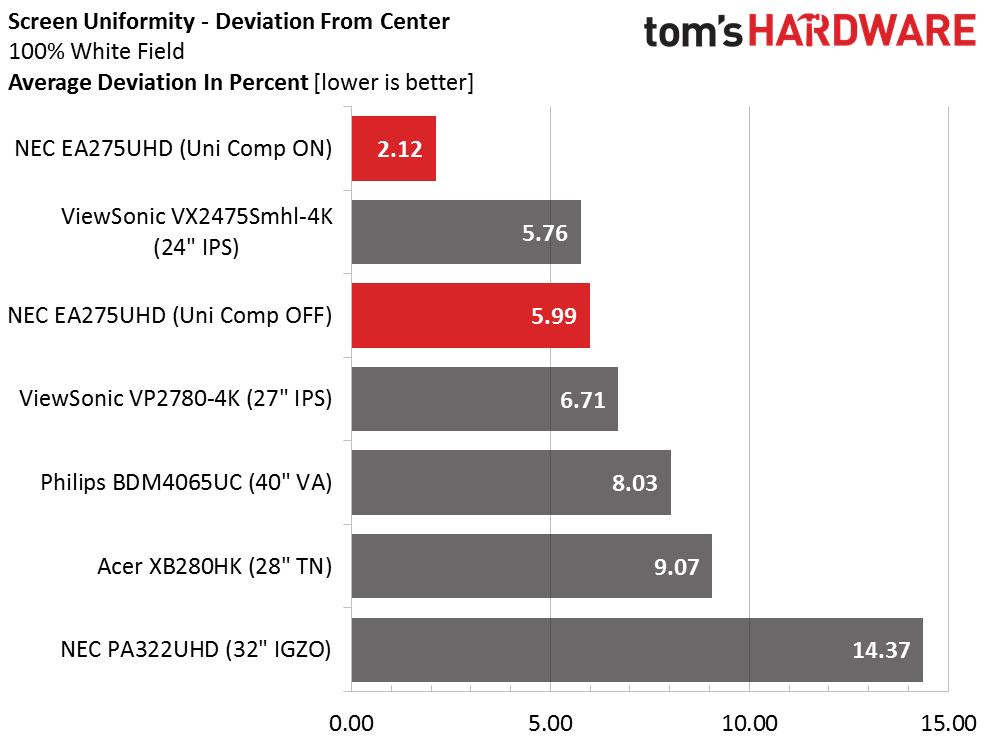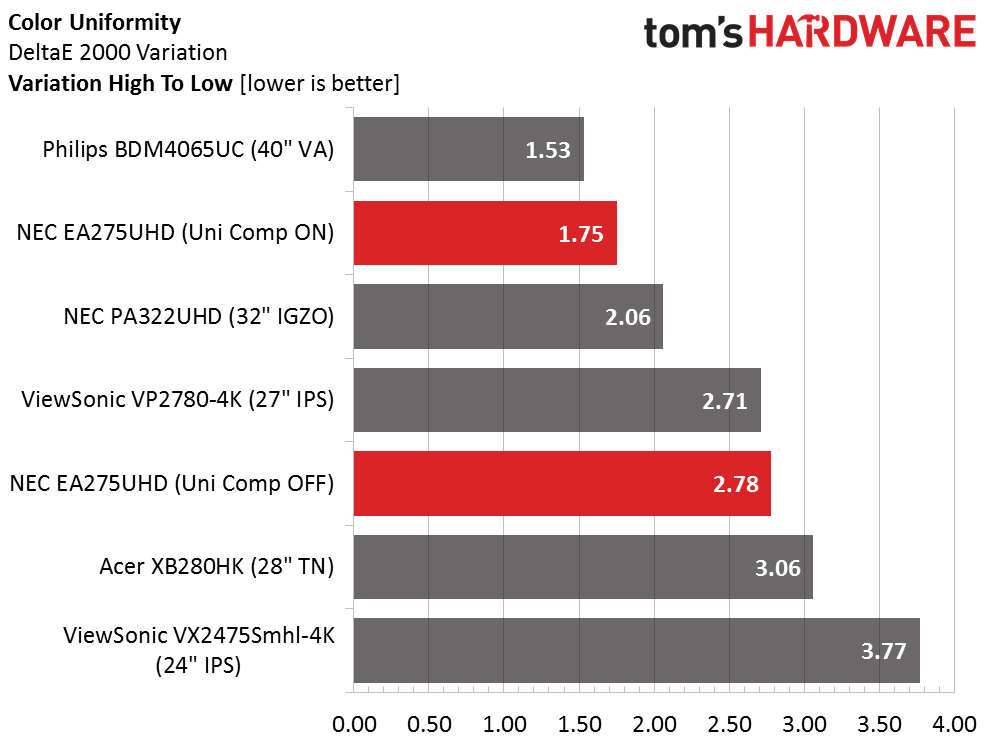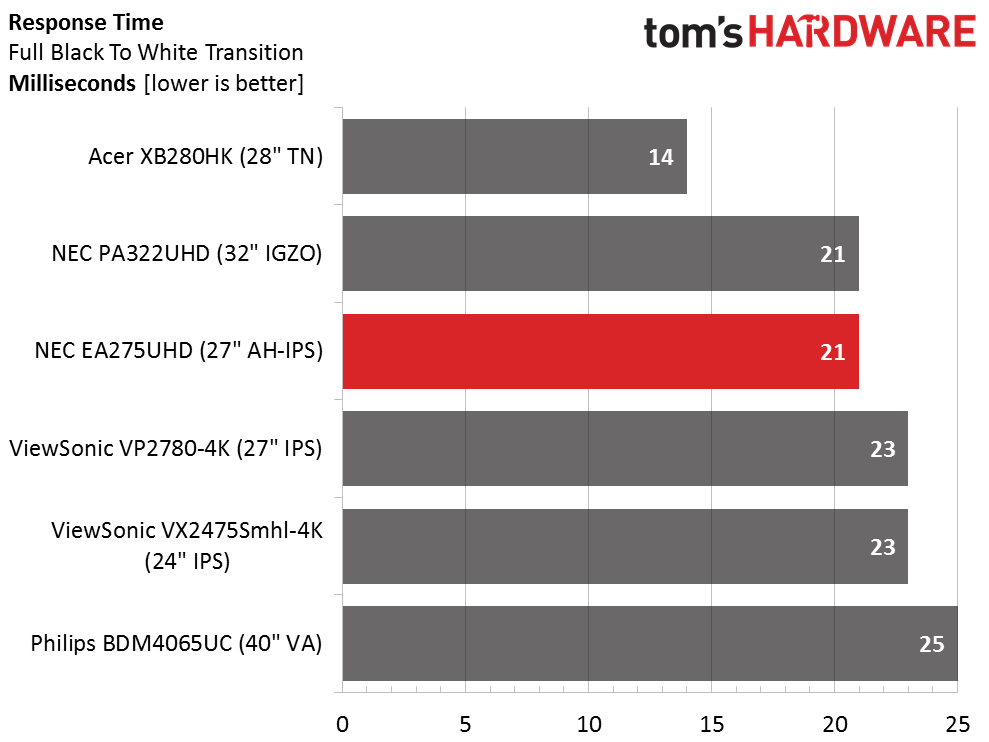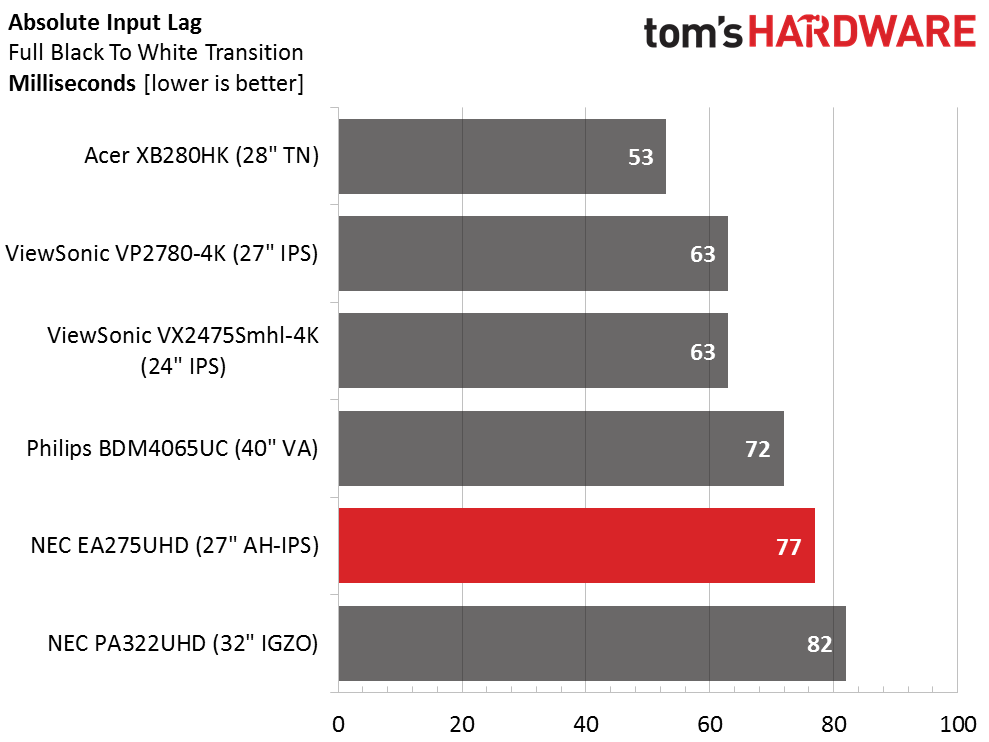NEC EA275UHD 27-inch UHD Monitor Review
NEC adds to its Ultra HD offerings with a 27-inch IPS model, the EA275UHD. Solid build quality and performance mark this enterprise-ready display.
Why you can trust Tom's Hardware
Viewing Angles, Uniformity, Response & Lag
To learn how we measure screen uniformity, please click here.
Off-axis viewing is pretty typical for an IPS panel. Light falloff to the sides is minimal but there is a red/green shift. From the top down you can see at least 50-percent less output but detail is retained pretty well. If you’re looking for a 27 or 28-inch Ultra HD display, the only way to enjoy the superior viewing angles of IPS is to go for the more-expensive 27-inch option. The 28-inchers are currently all TN-based.
Screen Uniformity: Luminance
NEC’s EA-series monitors have only on/off uniformity compensation. To get the five-level option, you have to buy a PA-series screen. As you can see in the EA275UHD’s case, the feature is both subtle and unnecessary. 6.99 percent is among the best we’ve recorded and a drop to 5.42 percent is not a difference you’ll be able to see. You will see the reduction in contrast however.
Here’s the white field measurement.
The improvement is greater in the white field test which tells us that NEC concentrates its correction on the brighter output levels. We’re still not convinced you should use the feature though. 5.99 percent beats many other monitors.
Screen Uniformity: Color
The improvement in color uniformity is fairly small. Neither result is visible to the naked eye. Our sample looks perfect from edge to edge. There are no color shifts nor are there hotspots or light bleed.
Pixel Response And Input Lag
Please click here to read up on our pixel response and input lag testing procedures.
Get Tom's Hardware's best news and in-depth reviews, straight to your inbox.
We don’t expect many gamers to shop this monitor but if you do, know that its response is fairly snappy among its 60Hz competition. Overdrive is turned on for this test and it improves motion blur without ghosting. The Acer remains the fastest 60Hz panel we’ve ever tested with its 14ms result.
Here are the lag results.
If you’re gaming in Ultra HD there are faster screens available. At 60Hz you’ll have a hard time besting the XB280HK but the EA275UHD is in line with the jumbo 32 and 40-inch models of the group. Until interface standards and graphics processors allow for higher refresh rates, you’ll have to drop to QHD or FHD resolution for the absolute lowest lag and motion blur.
Current page: Viewing Angles, Uniformity, Response & Lag
Prev Page Color Gamut & Performance Next Page Conclusion
Christian Eberle is a Contributing Editor for Tom's Hardware US. He's a veteran reviewer of A/V equipment, specializing in monitors. Christian began his obsession with tech when he built his first PC in 1991, a 286 running DOS 3.0 at a blazing 12MHz. In 2006, he undertook training from the Imaging Science Foundation in video calibration and testing and thus started a passion for precise imaging that persists to this day. He is also a professional musician with a degree from the New England Conservatory as a classical bassoonist which he used to good effect as a performer with the West Point Army Band from 1987 to 2013. He enjoys watching movies and listening to high-end audio in his custom-built home theater and can be seen riding trails near his home on a race-ready ICE VTX recumbent trike. Christian enjoys the endless summer in Florida where he lives with his wife and Chihuahua and plays with orchestras around the state.
-
deuce_23 This might be the one for me tho i would like a 32inch for gaming but 4k and HDMI cant really complain. It will nicely with my gtx 980ti. Now time to save! Whats that in Australian dollars?Reply -
oyoy Nice, nothing special, no serious news really to lighting up 2016. Good sRGB and great uniformity but RGB and color gamut are just faulty, that's a deal breaker ..maybe at $599. Will skip this one, waiting for better performance + price wise (Design + Little gaming here and there).Reply
Thanks for the review Christian Eberle -
thundervore NEC monitors are always great. Beats Dell and HP by a mile when it comes to their quality and performance to price. Even a nice height adjustable stand.Reply -
picture_perfect OK for photography & surfing. I don't think they are marketing it as a gaming monitor. Just as well unless you have a $1000 SLI set up to drive this excessive resolution. Low frame rates add persistence blur, stutter and lag,Reply -
epobirs I ordered one of these from Newegg today:Reply
http://www.lg.com/us/monitors/lg-27MU67-B-4k-uhd-led-monitor
It has Freesync, though the user doesn't go in for the games where the difference would make itself known. It's mainly to fill a gap in a household that has several devices that can drive 4K but no 4K displays on hand. I'm trying not to get my hopes overly high but it seems like a good unit for the price. -
erickw I’ve been the proud owner of an Eizo Flexscan 24”HD monitor for over 8 years (another monitor that was not really intended for gaming). Nonetheless, I’ve done a ton of gaming on this workhorse of a monitor (though not much in the way of fast paced shooters), along with many other applications. It has been an absolutely superlative gaming monitor, and I’ve long maintained that it makes virtually every other HD monitor I’ve seen pale in comparison. Depending on one’s specific needs (and pocketbook), monitors like this NEC can be excellent choices; even for gaming. I’m seriously looking at replacing my dearly loved (and hard to part wth) Eizo with this 4k beauty!Reply -
TwoMetreBill Keep in mind that for photo/video use, it is a QUADRO and not a GeForce that is needed for highest image quality. The GeForce is for gaming and not photo editing. For AMD I think the equivalent is the Pro series.Reply
In order to deliver a higher frame rate for gaming, the GeForce cuts off the rendering before it is complete.
